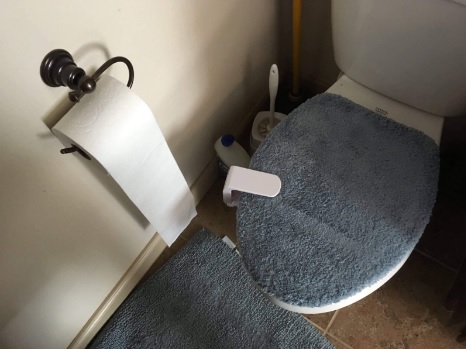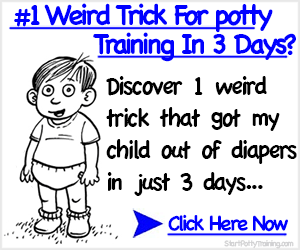
A curious child can get up to a lot of trouble in the bathroom, and dangers only begin with the possibility of your toddler flushing something important down the toilet. With so many hazards to consider, it’s important that you know which products you need to keep your baby safe.
Bathroom Childproofing Products
Toilet Baby Proofing Devices
Toilet Lid Safety Locks
There are a number of lockable devices for child proofing your toilet seat and bowl. The best fit for your situation depends on what you would find to be the most useful and convenient.
Most toilet lid safety locks latch onto the rim of the toilet to keep the lid, seat, and toilet bowl together. Clip-on devices don’t require any tools and must be removed before a toilet can be accessed. Don’t forget to put the clip back into position.
A swing shut toilet lock is attached to the tank with one end, and to the lid with the other one. It operates by swinging back into locking position when the lid is lowered.
Toilet Flush Handle Child Proofing
Children seem to love causing plumbing issues by flushing items. Certain devices help prevent your toddler from playfully flushing what doesn’t need to be in your plumbing.
Toilet handle safety covers fit over the flush lever and lock the handle in place. Adults must release the device to flush when needed.
Other flush handle devices are attached to the toilet tank, under the handle. They block the flush handle, and need to be released every time before flushing.
Toilet Paper Roll Saver
If you want to save yourself from constantly cleaning up wasted paper and replacing roll after roll, look into devices that protect your toilet paper holder.
A covered toilet paper dispenser can stop toddlers from wreaking havoc by limiting the amount of paper they have access to.
Similarly, toilet paper roll savers are devices that can be easily installed on the roll itself to keep small children from spinning a roll out of control.
Training Potty
When starting toilet training, you need to choose which training potty design meets your needs best, and safety is the number one factor to take into consideration.
Some devices feature a step stool and training seat that fits over the toilet lid, which can make using the toilet inconvenient for adults.
Devices that attach over toilet seats and can be readily removed require less clean-up, and some could also prevent playing in the toilet.
But since a small child may fall from a toilet, baby toilets that are separate from plumbing and look like miniature replicas of the real thing can be the safer option, as well as a simple potty.
Items for Bathtub, Shower, and Sink
Faucet Safety Locks and Covers
Kids may think the faucet for a sink, shower, or bathtub is a toy. To prevent accidental flooding, hot water burns or other problems, you may need to install baby proof faucet handles, locks, or covers depending on your preferences and the faucet itself.
Water faucet locks fit over or around the faucet to prevent the water being turned on.
Faucet knob covers stop your kiddo from boinking their head.
A bath spout tap fits entirely over the faucet and is meant for the same purpose, plus it distributes a powerful water jet, preventing your baby’s skin from bruises.
Bath Seat
Bathing your kiddo in a regular bathtub can feel like high-stakes juggling. Bath seats are helpful devices that keep your baby safely in place. They can be made of plastic or mesh material. Some designs feature adjustable suction cup applicators that will keep the seat upright and immovable, while others are stand-alone. Mesh bath seats can buckle in place and are possibly more comfortable, but could be comparably less sturdy.
Grab Bars
Hard surfaces get slippery during bath-time. Grab bars are safety measures that can help you and your child avoid painful falls. Many feature strong suction cups that don’t require tools to install. These handles can be fitted over glass, tile, or other smooth surfaces. However, it’s important to remember that a bar with suction cups may be unstable if the attached surface is porous or textured.
Non-Slip Mats
After your child begins to learn how to stand and walk, your toddler could easily try to stand in the bathtub. Attaching an adhesive non-slip mat to the bottom surface of your bathtub helps prevent injury. Secured commonly by suction cups, non-slip mats can solve many issues in navigating your bathroom safely.
These devices may also be installed inside a shower, bathtub, or over the room’s tile. In this guide you can find more information on baby safety products for bathing.
Bathroom Cabinet Latches
Your bathroom cabinet likely has a range of items that are dangerous for your child, such as medications, bath cleaning products, razors, and other choking hazards. To keep your little explorer from causing a mess or having an accident, you can install cabinet safety locks or latches.
Magnetic locks are opened with a magnet key. They are easy to install, as their components are attached to the cabinet interior by an adhesive tape. They don’t require drilling. Other locks close by turning or pressing a knob and require a hole in your cabinet to install.
You can use cord locks if you can install them high enough where they can’t be reached by your kid (they are easy to figure out). Other popular types include spring latches and swivel latches, which both catch the drawer’s edge or lip from being opened unless the latch is disengaged. Learn more about various types of cabinet locks here.
Electrical Outlet Covers
Choosing the right outlet safety cover is an important step in keeping your child safe from electrical dangers. Outlet plugs or caps are easily installed, but also easy for children to remove. Self-closing or sliding covers are great options that eliminate the danger of forgetting to close covers after use.
Box outlet covers completely close off an outlet and stop toddlers from unplugging devices themselves. Consider your household’s needs and the outlet type to find the right fit for you. Read more about the types of baby proof electrical outlet covers in this informative guide.
Door Locks and Stoppers
At first, simply locking your door to prevent your child from entering the bathroom alone is enough. However, once your toddler learns how to go to the toilet, the door should be left unlocked so the bathroom can be more readily used.
This means you may need to upgrade your baby-proofing measures to include door stoppers or pinch guards. These devices easily fit around a door’s edge to prevent shutting on fingers. This resource will provide you with more information on child safety devices for doors.
Additional Bathroom Child-Proofing Tips
Keep Sharp Objects and Medications in a Locked Cabinet
Curious kiddos need to be kept away from a number of things commonly found in bathrooms. Razors, tweezers, and other sharp objects used for personal grooming must be locked away. Likewise, medications need to be out of sight or reach.
Always Unplug Electrical Devices
Electrical devices, such as a hair blower or curling iron, left plugged in can cause burns, and if a toddler unplugs a device themselves, they could play with the exposed outlet. Don’t forget to tuck all electrical devices out of your child’s reach to avoid serious accidents.
Hide the Toilet Brush and Garbage Can
Thinking of what’s on a used toilet brush or inside a garbage can makes it obvious that you need to take preventive measures. You can baby-proof your toilet brush by hiding it in a cabinet or under the bathtub.
If your brush comes with a closed container, you can also use an adhesive, flexible strap lock on it. If you can’t find an unreachable place for a trash can, you can just remove it from the bathroom.
Clean Your Bathroom with Safe Cleaners
Babies are prone to touching and tasting anything within reach. However, products that claim to be “natural” can be misleading. Look for child-safe cleaners that don’t contain harsh chemicals, dyes, synthetic fragrances, or other problematic ingredients.
Conclusion
Baby proofing a bathroom seems a simple job yet, in fact, it requires a lot of experience to try and know what potential hazards should be alimented to keep your little ones safe.
While some safety features are easily implemented by a parent, others require a skilled technician. If you don’t want to risk your baby’s safety, it is often advised to find a childproofing professional. You can find licensed baby proofers at directories like YouthfulHome.com or search online.
Always remember, never try to install a safety equipment in your bathroom if you are not 100% sure how it should be installed. It is always better to hire a professional to be safe than sorry!





